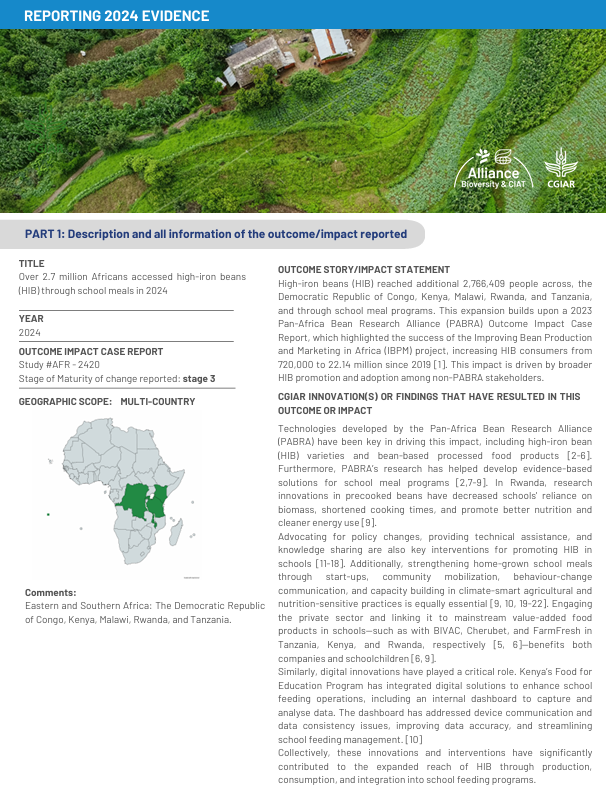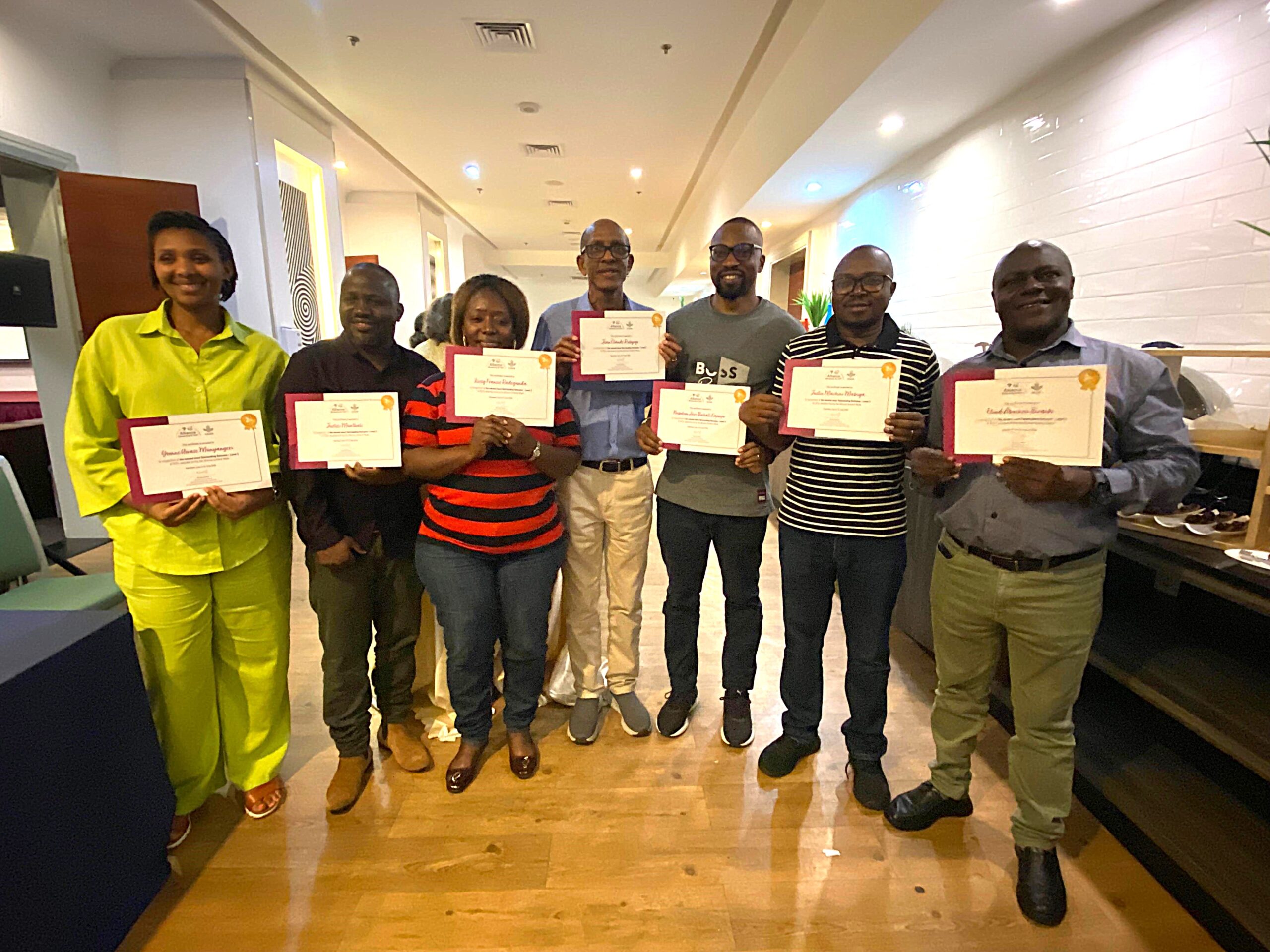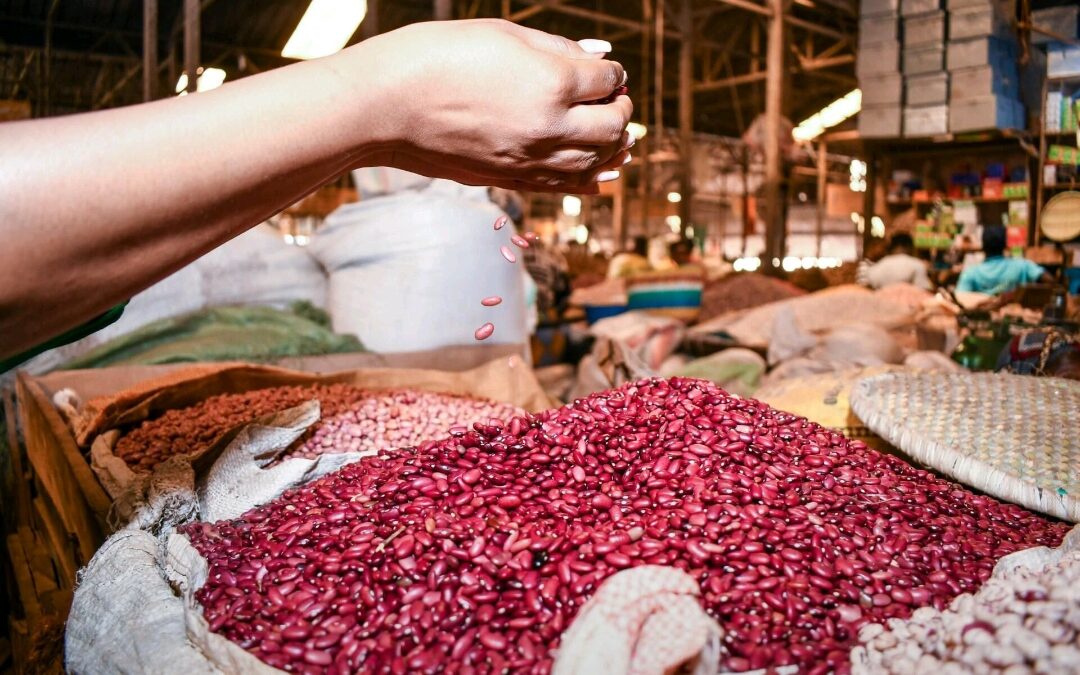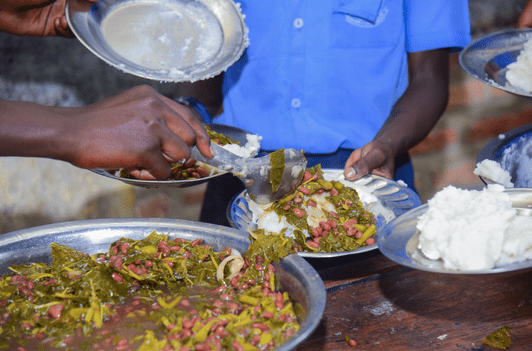By Napoleon Kajunju, Justice Munthali, Yohane Chideya, Eliud Birachi, and Jean Claude Rubyogo
Over 2.7 million people have benefitted from biofortified beans disseminated through school meal programs in five African countries. Iron-rich beans can be integrated into consumers’ diets to enhance nutrition and cognitive function, especially for children and youth. But how can this be achieved at scale?
Schools represent a strong entry point. Accumulated evidence shows large-scale nutrition gains through collaborative efforts to integrate biofortified high-iron beans into school feeding programs across Rwanda, Kenya, Tanzania, Malawi, and the Democratic Republic of Congo. In 2024 alone, 2.77 million people benefitted—an outcome made possible by coordinated efforts among governments, NGOs, the private sector, and global partners under the Pan-Africa Bean Research Alliance (PABRA).
Read the Impact Report
 Led by Justice Munthali, this report builds on growth from 720,000 HIB consumers in 2019 to over 22 million by 2023, driven by strategic investments in nutrition, school meals, and climate-smart agriculture. Scientific advances behind this impact include the development of biofortified bean varieties with enhanced iron content, high bioavailability, and climate-smart traits, alongside processed HIB products like composite flours and precooked beans that reduce cooking time and energy use. Evidence-based delivery models, such as Rwanda’s Sustainable School Feeding Innovations (SSFI), reached over 277,000 students in 195 schools while also generating carbon credits. Digital innovations like Kenya’s school meal dashboard, part of the Food for Education Program, improved meal delivery and learning outcomes for over 170,000 students daily. Country-level success stories illustrate the breadth of the impact.
Led by Justice Munthali, this report builds on growth from 720,000 HIB consumers in 2019 to over 22 million by 2023, driven by strategic investments in nutrition, school meals, and climate-smart agriculture. Scientific advances behind this impact include the development of biofortified bean varieties with enhanced iron content, high bioavailability, and climate-smart traits, alongside processed HIB products like composite flours and precooked beans that reduce cooking time and energy use. Evidence-based delivery models, such as Rwanda’s Sustainable School Feeding Innovations (SSFI), reached over 277,000 students in 195 schools while also generating carbon credits. Digital innovations like Kenya’s school meal dashboard, part of the Food for Education Program, improved meal delivery and learning outcomes for over 170,000 students daily. Country-level success stories illustrate the breadth of the impact.
In Rwanda, Farm Fresh’s precooked beans improved school meals and nutrition while lowering carbon emissions. In 2024 alone, 277,566 students across 195 schools benefited from HIB-based meals. In Tanzania, HIB has reached 915 schools since 2015, serving over 402,000 students; AGRA’s school meal initiative alone has impacted over 400,000 children. Kenya’s Food for Education Program provides daily HIB-rich meals to 170,000 students, with an additional 7,060 children reached in five counties and over 400,000 children nationwide impacted through AGRA-supported efforts.
Furthermore, in Malawi, nearly 500,000 students across 106 schools accessed HIB meals, with a Waterloo Foundation project reaching 6,000 learners in 20 schools. The World Food Programme plans to expand this model to potentially serve 200,000 students in 200 schools. In DRC, under the Beans for Women Empowerment (B4WE) and Integrated Project on Agricultural Growth in the Great Lakes region (PICAGL) initiatives, seed packs and demonstrations reached 2,911 students and community members.
A network for nutrition at scale
This scale-up has been supported by a wide network of partners, including the Alliance for a Green Revolution in Africa (AGRA), HarvestPlus, the Rockefeller Foundation, World Food Programme (WFP), Food and Agriculture Organization (FAO), Global Alliance for Improved Nutrition (GAIN), Caritas, World Vision, Nascent Solutions, Clinton Foundation, Centre for Behaviour Change and Communication (CBCC), Actions for Development Programmes (ADP) Mbozi, Research, Community, and Development Associates, and the Youth Peace Maker Organization. Private sector partners such as Cherubet, BIVAC, Crop Bioscience Solution (CBS), Farm Fresh Food Company, Agriche Foods, and Tawina also played vital roles.
PABRA’s approach emphasizes inclusion, gender equity, and climate resilience. Women and youth are central to bean processing enterprises and monitoring adoption, while HIB varieties support sustainable agriculture by improving soil health and enabling carbon credit systems.
Capacity-building programs have empowered teachers, students, civil servants, and entrepreneurs with knowledge in nutrition, value chains, and sustainable farming.
The outcomes align with several UN Sustainable Development Goals: SDG 2 (Zero Hunger), by ensuring access to nutrient-rich food; SDG 3 (Good Health and Well-being), by improving iron intake and child development; and SDG 13 (Climate Action), through low-energy cooking solutions and carbon offset initiatives. The work also supports One CGIAR’s strategic pillars of nutrition, climate adaptation, poverty reduction, gender equality, and ecosystem health.
This work reinforces the value of continued investment in biofortified crops, school meal systems, and inclusive, resilient food solutions for impact at scale. As PABRA continues to expand its innovations, the High-Iron Beans story stands as a powerful model for transforming food systems across Africa—and globally.

Proud Moments: At the Alliance’s 2025 Science Week in Laos, the work was recognized as an outstanding impact case study, indicating large-scale results backed by rigorous data and stakeholder collaboration. Authors of the report celebrate their achievement with certificates for their valuable contributions.


